2013 CHEVROLET CAPTIVA SPORT light
[x] Cancel search: lightPage 215 of 374
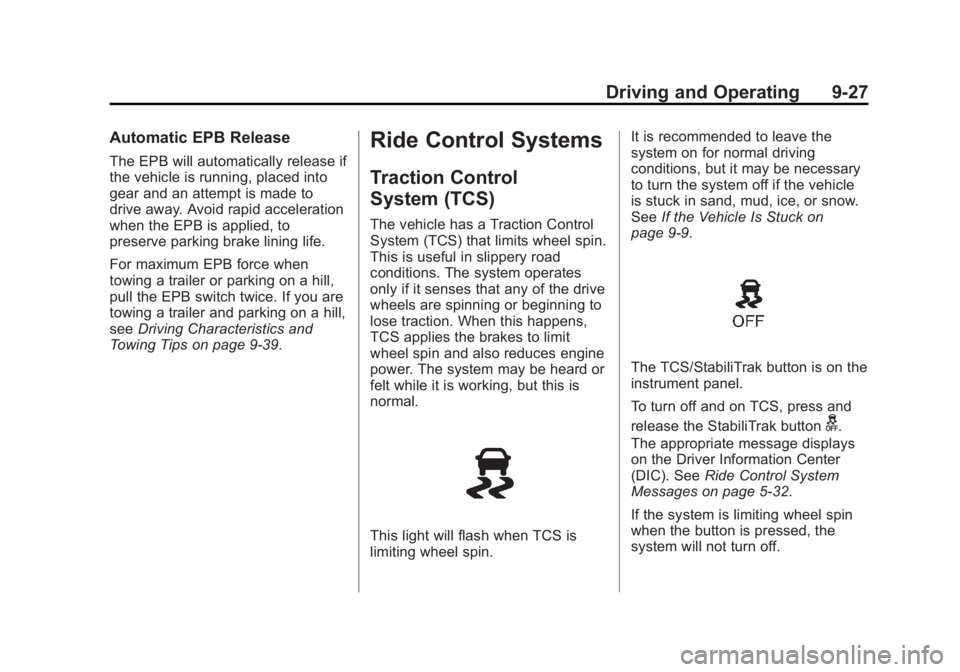
Black plate (27,1)Chevrolet Captiva Sport Owner Manual - 2013 - crc - 11/12/12
Driving and Operating 9-27Automatic EPB Release The EPB will automatically release if
the vehicle is running, placed into
gear and an attempt is made to
drive away. Avoid rapid acceleration
when the EPB is applied, to
preserve parking brake lining life.
For maximum EPB force when
towing a trailer or parking on a hill,
pull the EPB switch twice. If you are
towing a trailer and parking on a hill,
see Driving Characteristics and
Towing Tips on page 9 ‑ 39 .Ride Control Systems Traction Control
System (TCS) The vehicle has a Traction Control
System (TCS) that limits wheel spin.
This is useful in slippery road
conditions. The system operates
only if it senses that any of the drive
wheels are spinning or beginning to
lose traction. When this happens,
TCS applies the brakes to limit
wheel spin and also reduces engine
power. The system may be heard or
felt while it is working, but this is
normal.
This light will flash when TCS is
limiting wheel spin. It is recommended to leave the
system on for normal driving
conditions, but it may be necessary
to turn the system off if the vehicle
is stuck in sand, mud, ice, or snow.
See If the Vehicle Is Stuck on
page 9 ‑ 9 .
The TCS/StabiliTrak button is on the
instrument panel.
To turn off and on TCS, press and
release the StabiliTrak button
g .
The appropriate message displays
on the Driver Information Center
(DIC). See Ride Control System
Messages on page 5 ‑ 32 .
If the system is limiting wheel spin
when the button is pressed, the
system will not turn off.
Page 216 of 374

Black plate (28,1)Chevrolet Captiva Sport Owner Manual - 2013 - crc - 11/12/12
9-28 Driving and Operating Adding non-dealer accessories can
affect the vehicle's performance.
See Accessories and Modifications
on page 10 ‑ 2 .
Brake Pedal Override This vehicle has this feature that
limits engine torque when the brake
pedal is applied. If there is one foot
on the brake pedal and the other
foot on the accelerator, the engine
rpm will only climb to slightly more
than idle speed.
This feature is enabled at vehicle
start. Press and release the TCS/
StabiliTrak button
g to disable or
enable this feature and TCS. The
appropriate message will display on
the DIC. See Ride Control System
Messages on page 5 ‑ 32 .
StabiliTrak ®
SystemThe vehicle has a stability control
system called StabiliTrak which
combines antilock brake, traction,
and stability control systems and helps the driver maintain directional
control of the vehicle in most driving
conditions.
StabiliTrak activates when the
computer senses a difference
between the intended path and the
direction the vehicle is actually
traveling. StabiliTrak selectively
applies braking pressure at any one
of the vehicle's brakes to assist the
driver with keeping the vehicle on
the intended path.
When the vehicle is started and
begins to move, the system
performs several diagnostic checks
to ensure that there are no
problems. The system may be
heard or felt while it is working. This
is normal and does not mean there
is a problem with the vehicle. This light is on the instrument
cluster.
It will flash when StabiliTrak is both
on and activated.
If the system fails to turn on or
activate, this light will be on solid.
When the light is on solid, the
system will not assist the driver
maintain directional control of the
vehicle. Adjust your driving
accordingly.
The StabiliTrak system
automatically comes on whenever
the vehicle is started. To assist the
driver with vehicle directional
control, especially in slippery road
conditions, the system should
always be left on. StabiliTrak can be
turned off if needed.
Page 217 of 374
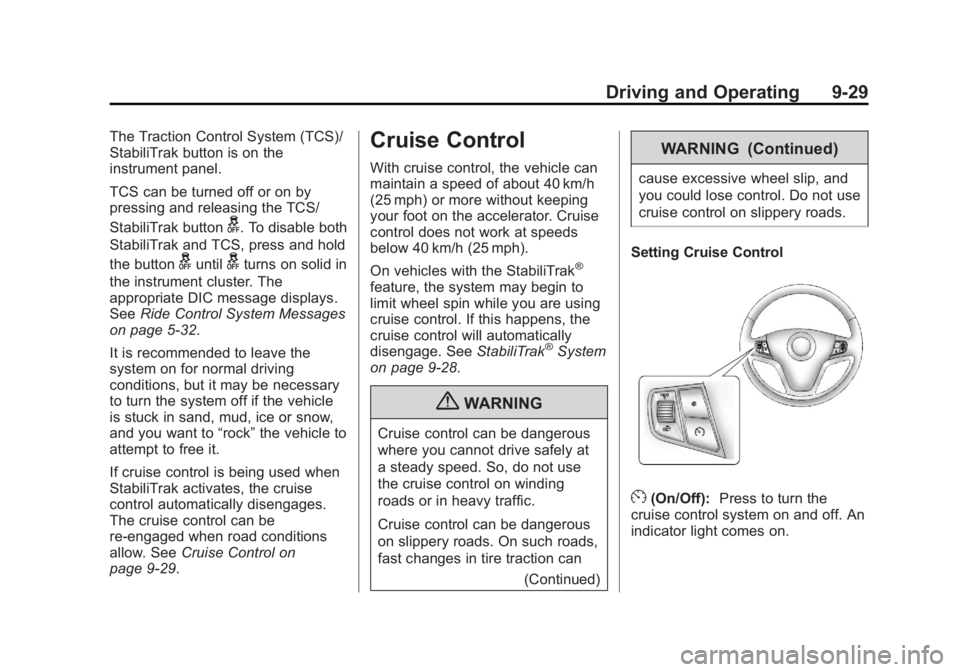
Black plate (29,1)Chevrolet Captiva Sport Owner Manual - 2013 - crc - 11/12/12
Driving and Operating 9-29The Traction Control System (TCS)/
StabiliTrak button is on the
instrument panel.
TCS can be turned off or on by
pressing and releasing the TCS/
StabiliTrak button
g . To disable both
StabiliTrak and TCS, press and hold
the button
g until
g turns on solid in
the instrument cluster. The
appropriate DIC message displays.
See Ride Control System Messages
on page 5 ‑ 32 .
It is recommended to leave the
system on for normal driving
conditions, but it may be necessary
to turn the system off if the vehicle
is stuck in sand, mud, ice or snow,
and you want to “ rock ” the vehicle to
attempt to free it.
If cruise control is being used when
StabiliTrak activates, the cruise
control automatically disengages.
The cruise control can be
re-engaged when road conditions
allow. See Cruise Control on
page 9 ‑ 29 . Cruise Control With cruise control, the vehicle can
maintain a speed of about 40 km/h
(25 mph) or more without keeping
your foot on the accelerator. Cruise
control does not work at speeds
below 40 km/h (25 mph).
On vehicles with the StabiliTrak ®
feature, the system may begin to
limit wheel spin while you are using
cruise control. If this happens, the
cruise control will automatically
disengage. See StabiliTrak ®
System
on page 9 ‑ 28 .
{ WARNING
Cruise control can be dangerous
where you cannot drive safely at
a steady speed. So, do not use
the cruise control on winding
roads or in heavy traffic.
Cruise control can be dangerous
on slippery roads. On such roads,
fast changes in tire traction can
(Continued) WARNING (Continued) cause excessive wheel slip, and
you could lose control. Do not use
cruise control on slippery roads.
Setting Cruise Control
E (On/Off): Press to turn the
cruise control system on and off. An
indicator light comes on.
Page 218 of 374
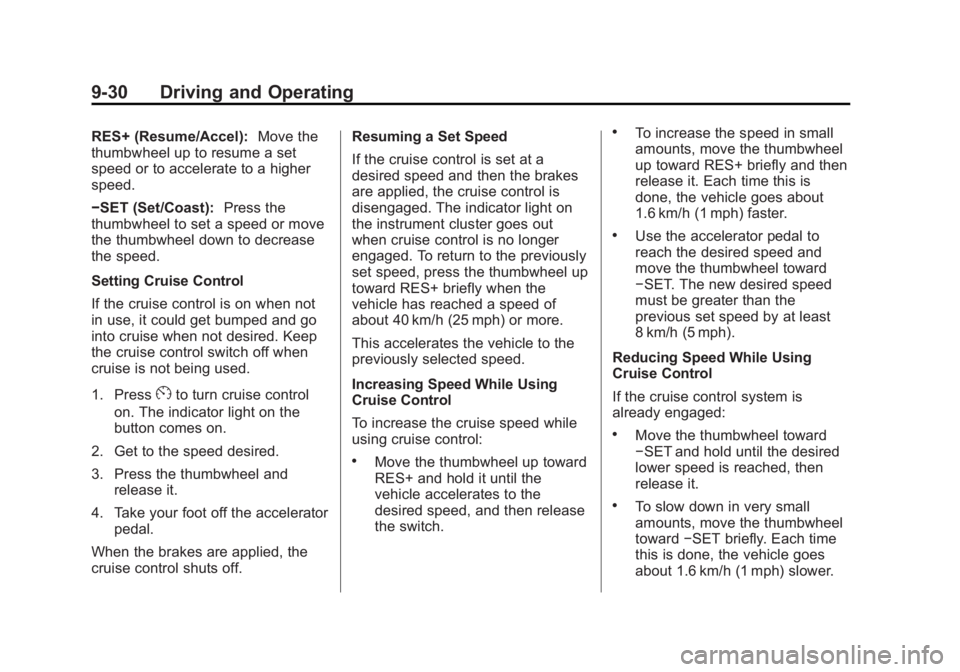
Black plate (30,1)Chevrolet Captiva Sport Owner Manual - 2013 - crc - 11/12/12
9-30 Driving and Operating RES+ (Resume/Accel): Move the
thumbwheel up to resume a set
speed or to accelerate to a higher
speed.
− SET (Set/Coast): Press the
thumbwheel to set a speed or move
the thumbwheel down to decrease
the speed.
Setting Cruise Control
If the cruise control is on when not
in use, it could get bumped and go
into cruise when not desired. Keep
the cruise control switch off when
cruise is not being used.
1. Press
E to turn cruise control
on. The indicator light on the
button comes on.
2. Get to the speed desired.
3. Press the thumbwheel and
release it.
4. Take your foot off the accelerator
pedal.
When the brakes are applied, the
cruise control shuts off. Resuming a Set Speed
If the cruise control is set at a
desired speed and then the brakes
are applied, the cruise control is
disengaged. The indicator light on
the instrument cluster goes out
when cruise control is no longer
engaged. To return to the previously
set speed, press the thumbwheel up
toward RES+ briefly when the
vehicle has reached a speed of
about 40 km/h (25 mph) or more.
This accelerates the vehicle to the
previously selected speed.
Increasing Speed While Using
Cruise Control
To increase the cruise speed while
using cruise control: .
Move the thumbwheel up toward
RES+ and hold it until the
vehicle accelerates to the
desired speed, and then release
the switch. .
To increase the speed in small
amounts, move the thumbwheel
up toward RES+ briefly and then
release it. Each time this is
done, the vehicle goes about
1.6 km/h (1 mph) faster. .
Use the accelerator pedal to
reach the desired speed and
move the thumbwheel toward
− SET. The new desired speed
must be greater than the
previous set speed by at least
8 km/h (5 mph).
Reducing Speed While Using
Cruise Control
If the cruise control system is
already engaged: .
Move the thumbwheel toward
− SET and hold until the desired
lower speed is reached, then
release it. .
To slow down in very small
amounts, move the thumbwheel
toward − SET briefly. Each time
this is done, the vehicle goes
about 1.6 km/h (1 mph) slower.
Page 219 of 374
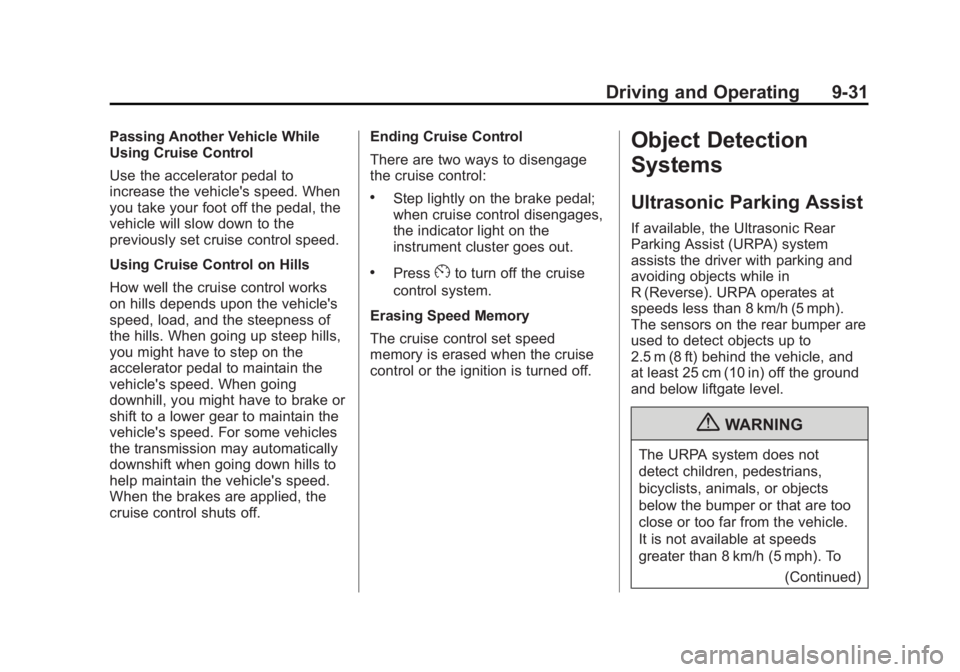
Black plate (31,1)Chevrolet Captiva Sport Owner Manual - 2013 - crc - 11/12/12
Driving and Operating 9-31Passing Another Vehicle While
Using Cruise Control
Use the accelerator pedal to
increase the vehicle's speed. When
you take your foot off the pedal, the
vehicle will slow down to the
previously set cruise control speed.
Using Cruise Control on Hills
How well the cruise control works
on hills depends upon the vehicle's
speed, load, and the steepness of
the hills. When going up steep hills,
you might have to step on the
accelerator pedal to maintain the
vehicle's speed. When going
downhill, you might have to brake or
shift to a lower gear to maintain the
vehicle's speed. For some vehicles
the transmission may automatically
downshift when going down hills to
help maintain the vehicle's speed.
When the brakes are applied, the
cruise control shuts off. Ending Cruise Control
There are two ways to disengage
the cruise control: .
Step lightly on the brake pedal;
when cruise control disengages,
the indicator light on the
instrument cluster goes out. .
Press
E to turn off the cruise
control system.
Erasing Speed Memory
The cruise control set speed
memory is erased when the cruise
control or the ignition is turned off. Object Detection
Systems Ultrasonic Parking Assist If available, the Ultrasonic Rear
Parking Assist (URPA) system
assists the driver with parking and
avoiding objects while in
R (Reverse). URPA operates at
speeds less than 8 km/h (5 mph).
The sensors on the rear bumper are
used to detect objects up to
2.5 m (8 ft) behind the vehicle, and
at least 25 cm (10 in) off the ground
and below liftgate level.
{ WARNING
The URPA system does not
detect children, pedestrians,
bicyclists, animals, or objects
below the bumper or that are too
close or too far from the vehicle.
It is not available at speeds
greater than 8 km/h (5 mph). To
(Continued)
Page 222 of 374
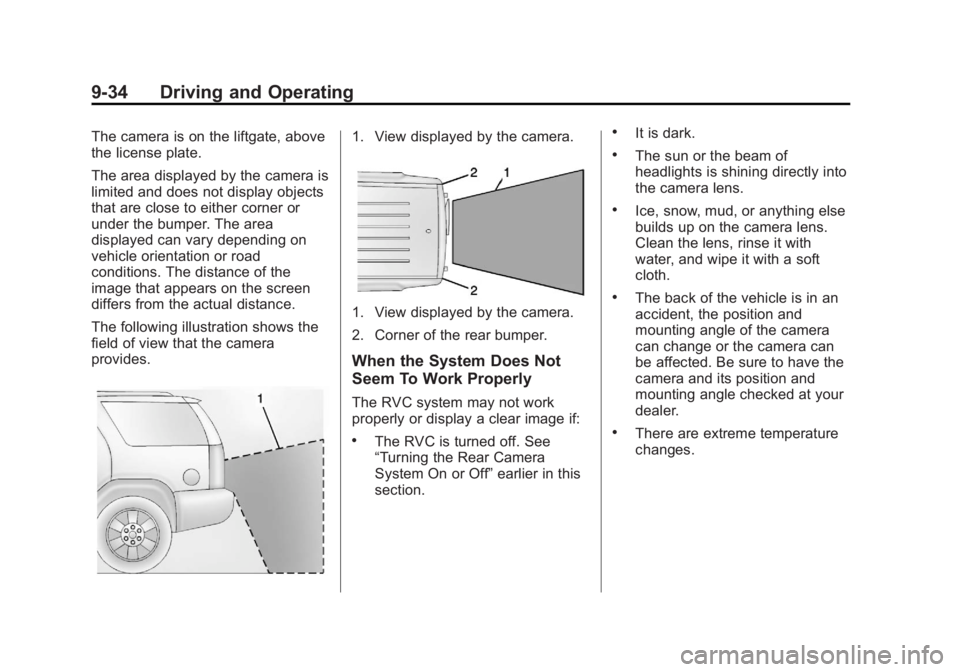
Black plate (34,1)Chevrolet Captiva Sport Owner Manual - 2013 - crc - 11/12/12
9-34 Driving and Operating The camera is on the liftgate, above
the license plate.
The area displayed by the camera is
limited and does not display objects
that are close to either corner or
under the bumper. The area
displayed can vary depending on
vehicle orientation or road
conditions. The distance of the
image that appears on the screen
differs from the actual distance.
The following illustration shows the
field of view that the camera
provides. 1. View displayed by the camera.
1. View displayed by the camera.
2. Corner of the rear bumper.
When the System Does Not
Seem To Work Properly The RVC system may not work
properly or display a clear image if: .
The RVC is turned off. See
“ Turning the Rear Camera
System On or Off ” earlier in this
section. .
It is dark. .
The sun or the beam of
headlights is shining directly into
the camera lens. .
Ice, snow, mud, or anything else
builds up on the camera lens.
Clean the lens, rinse it with
water, and wipe it with a soft
cloth. .
The back of the vehicle is in an
accident, the position and
mounting angle of the camera
can change or the camera can
be affected. Be sure to have the
camera and its position and
mounting angle checked at your
dealer. .
There are extreme temperature
changes.
Page 226 of 374
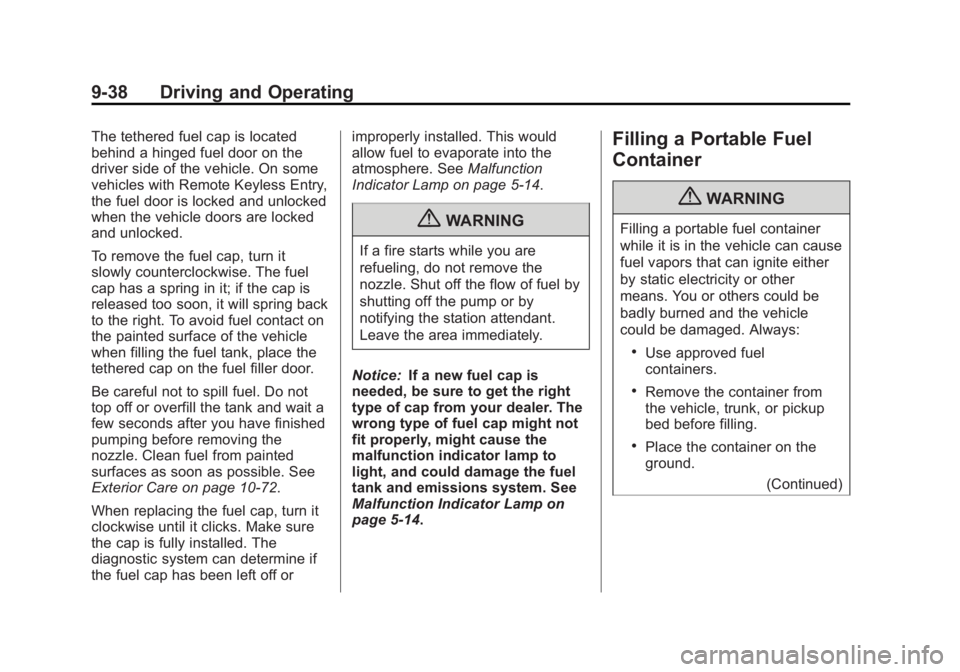
Black plate (38,1)Chevrolet Captiva Sport Owner Manual - 2013 - crc - 11/12/12
9-38 Driving and Operating The tethered fuel cap is located
behind a hinged fuel door on the
driver side of the vehicle. On some
vehicles with Remote Keyless Entry,
the fuel door is locked and unlocked
when the vehicle doors are locked
and unlocked.
To remove the fuel cap, turn it
slowly counterclockwise. The fuel
cap has a spring in it; if the cap is
released too soon, it will spring back
to the right. To avoid fuel contact on
the painted surface of the vehicle
when filling the fuel tank, place the
tethered cap on the fuel filler door.
Be careful not to spill fuel. Do not
top off or overfill the tank and wait a
few seconds after you have finished
pumping before removing the
nozzle. Clean fuel from painted
surfaces as soon as possible. See
Exterior Care on page 10 ‑ 72 .
When replacing the fuel cap, turn it
clockwise until it clicks. Make sure
the cap is fully installed. The
diagnostic system can determine if
the fuel cap has been left off or improperly installed. This would
allow fuel to evaporate into the
atmosphere. See Malfunction
Indicator Lamp on page 5 ‑ 14 .
{ WARNINGIf a fire starts while you are
refueling, do not remove the
nozzle. Shut off the flow of fuel by
shutting off the pump or by
notifying the station attendant.
Leave the area immediately.
Notice: If a new fuel cap is
needed, be sure to get the right
type of cap from your dealer. The
wrong type of fuel cap might not
fit properly, might cause the
malfunction indicator lamp to
light, and could damage the fuel
tank and emissions system. See
Malfunction Indicator Lamp on
page 5 ‑ 14 . Filling a Portable Fuel
Container
{ WARNINGFilling a portable fuel container
while it is in the vehicle can cause
fuel vapors that can ignite either
by static electricity or other
means. You or others could be
badly burned and the vehicle
could be damaged. Always: .
Use approved fuel
containers. .
Remove the container from
the vehicle, trunk, or pickup
bed before filling. .
Place the container on the
ground.
(Continued)
Page 227 of 374
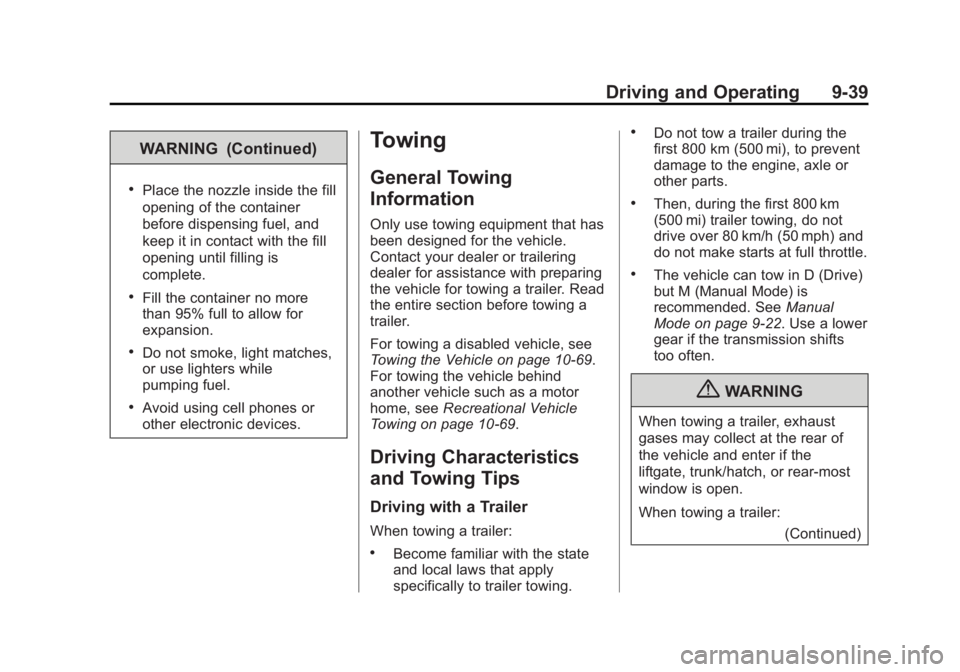
Black plate (39,1)Chevrolet Captiva Sport Owner Manual - 2013 - crc - 11/12/12
Driving and Operating 9-39WARNING (Continued) .
Place the nozzle inside the fill
opening of the container
before dispensing fuel, and
keep it in contact with the fill
opening until filling is
complete. .
Fill the container no more
than 95% full to allow for
expansion. .
Do not smoke, light matches,
or use lighters while
pumping fuel. .
Avoid using cell phones or
other electronic devices. Towing General Towing
Information Only use towing equipment that has
been designed for the vehicle.
Contact your dealer or trailering
dealer for assistance with preparing
the vehicle for towing a trailer. Read
the entire section before towing a
trailer.
For towing a disabled vehicle, see
Towing the Vehicle on page 10 ‑ 69 .
For towing the vehicle behind
another vehicle such as a motor
home, see Recreational Vehicle
Towing on page 10 ‑ 69 .
Driving Characteristics
and Towing Tips Driving with a Trailer
When towing a trailer: .
Become familiar with the state
and local laws that apply
specifically to trailer towing. .
Do not tow a trailer during the
first 800 km (500 mi), to prevent
damage to the engine, axle or
other parts. .
Then, during the first 800 km
(500 mi) trailer towing, do not
drive over 80 km/h (50 mph) and
do not make starts at full throttle. .
The vehicle can tow in D (Drive)
but M (Manual Mode) is
recommended. See Manual
Mode on page 9 ‑ 22 . Use a lower
gear if the transmission shifts
too often.
{ WARNING
When towing a trailer, exhaust
gases may collect at the rear of
the vehicle and enter if the
liftgate, trunk/hatch, or rear-most
window is open.
When towing a trailer:
(Continued)